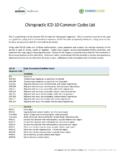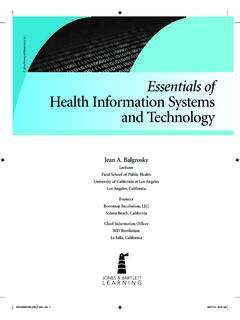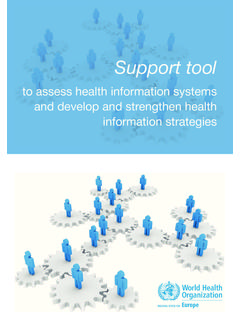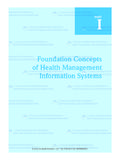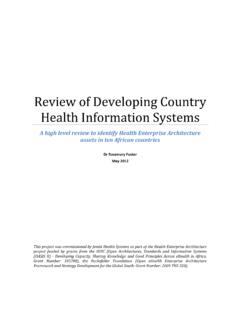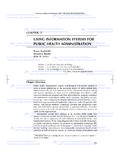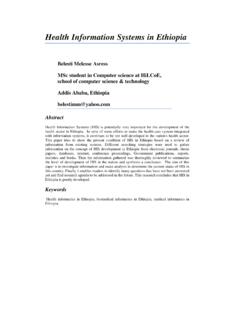Transcription of GLOSSARY OF HEALTH INFORMATION …
1 GLOSSARY OF HEALTH INFORMATION technology TERMS 3G (Third-Generation) Network: Advanced cellular network supporting data transfer speeds from 144kbps to 2 Mbps (theoretically). Cellular carriers hope to use 3G service to deliver advanced features such as Web browsing and streaming video. : A wireless networking standard ratified by the IEEE in late 1999 and supported by the largest wireless local area network (WLAN) vendors. Also known as Wi-Fi. Access Point: Radio-based device that provides users of wireless devices with access to a local area network (LAN). AHIC (American HEALTH INFORMATION Community): Also known as "the Community") formed to help advance efforts to reach the president s call for most Americans to have electronic HEALTH records by 2014. See AHIMA (American HEALTH INFORMATION Management system ): A community of professionals engaged in HEALTH INFORMATION management, providing support to members and strengthening the industry and profession.
2 See AMIA (American Medical Informatics Association): The first professional group to issue guidelines for physician-patient e-mail. AMR (Ambulatory Medical Record): A computer system for storing, managing, and retrieving electronic patient HEALTH INFORMATION in the outpatient setting. In the inpatient setting, it is often referred to as an electronic medical record (EMR). ANSI (American National Standards Institute): The standards organization that establishes procedures for the development and coordination of voluntary American National Standards. Architecture: This term refers to the structure of an INFORMATION system and how its pieces communicate and work together. Also see client/server and tiered architecture. ASP (Application Service Provider): A business that deploys, hosts, and manages access to software applications for multiple parties from a central facility. The ASP charges a subscription fee to users of the applications, which are delivered over the Internet or other public or private networks.
3 ASTM International (American Society for Testing and Materials): Was formed over a century ago, when a forward-thinking group of engineers and scientists got together to address frequent rail breaks in the burgeoning railroad industry. Total, standards developed at ASTM are the work of over 30,000 ASTM members. These technical experts represent producers, users, consumers, government and academia from over 2100 countries. Participation in ASTM International is open to all with a material interest, anywhere in the world. Bandwidth: A measure of how much INFORMATION can be transmitted at once through a communication medium, such as a telephone line, fiber-optic cable, or radio frequency. Beaming: Transfer of data or software programs between devices, such as PDAs, personal computers and printers, using either infrared or radio-wave transmission. Bioinformatics: The science of developing and using computer databases and algorithms to hasten and improve biological and pharmaceutical research.
4 Biometric Authentication: technology that identifies a person through recognition of unique physical characteristics, such as retina or iris patterns, face shape, voice patterns or fingerprints. Bluetooth: A protocol designed for short-range wireless communication or networking among a variety of devices. Somewhat similar to, but distinct from, Broadband: A medium that can carry multiple signals, or channels of INFORMATION , at the same time without interference. Broadband Internet connections enable high-resolution videoconferencing and other applications that require rapid, synchronous exchange of data. Browser: A software program that interprets documents written in HTML, the primary programming language of the Web. A browser such as Netscape Navigator or Microsoft Explorer is required to experience the photos, video, and sound elements on a Web page and assists in quick, easy travel around the Web.
5 C+/C++: C is an established programming language found in many operating systems, including UNIX. C++, a daughter program based on objects, is quickly becoming a favored programming language as object-oriented technology gains popularity. Also see Java. CCHIT (Certification Commission for Healthcare INFORMATION technology ): A voluntary, private-sector organization launched in 2004 to certify HEALTH INFORMATION technology (HIT) products such as electronic HEALTH records and the networks over which they interoperate. See CCR (Continuity of Care Record): A standard specification being developed jointly by ASTM International, the Massachusetts Medical Society (MMS), the HEALTH INFORMATION Management and Systems Society (HIMSS), the American Academy of Family Physicians (AAFP), and the American Academy of Pediatrics. It is intended to foster and improve continuity of patient care, to reduce medical errors, and to assure at least a minimum standard of HEALTH INFORMATION transportability when a patient is referred or transferred to, or is otherwise seen by, another provider.
6 The origins of the CCR stem 3from a Massachusetts Department of Public HEALTH , three-page, NCR paper-based Patient Care Referral Form that has been in widespread use for many years in Massachusetts, and from other minimal data sets both electronic and paper-based. The CCR is being developed and enhanced in response to the need to organize a set of basic patient INFORMATION consisting of the most relevant and timely facts about a patient s condition. Briefly, these include diagnoses, recent procedures, allergies, medications, recent care provided, as well as recommendations for future care (care plan) and the reason for referral or transfer. The CCR will be created by a healthcare provider/clinician at the end of an encounter, or at the end of an episode of care, such as a hospital or rehabilitation stay. CDS (Clinical Decision Support): Clinical decision support systems (CDSS) assist the physician in applying new INFORMATION to patient care and help to prevent medical errors and improve patient safety.
7 Many of these systems include computer-based programs that analyze INFORMATION entered by the physician. CDA (Clinical Document Architecture): Provides an exchange model for clinical documents and brings the industry closer to the realization of an electronic medical record. CHI (Consolidated HEALTH Informatics) Initiative: One of the 24 Presidential eGovernment initiatives with the goal of adopting vocabulary and messaging standards to facilitate communication of clinical INFORMATION across the federal HEALTH enterprise. CHI now falls under FHA. CIS (Clinical INFORMATION system ): An Electronic HEALTH record that is a clinical repository of patient data. The term CIS is sometimes used interchangeably with EMR. Typically covers: Pathology and radiology order entry and results reporting; Medication prescribing, supply and administration; Clinical work lists; Problem lists; Clinical notes; and Decision support.
8 Client: In a computer network, a workstation that retrieves INFORMATION from a server. Client/server: A network system in which a dedicated computer (server) handles some data storage and processing tasks for applications used on personal computers or workstations (clients), which tap the server s shared files and processing power as needed. Also see distributed computing. CPOE (Computerized Provider Order Entry): A computer application that allows a physician's orders for diagnostic and treatment services (such as medications, laboratory, and other tests) to be entered electronically instead of being recorded on 4order sheets or prescription pads. The computer compares the order against standards for dosing, checks for allergies or interactions with other medications, and warns the physician about potential problems. CRM (Customer Relationship Management): INFORMATION systems and software that enable an organization to manage customers in an organized way with the objective of building better customer relationships.
9 Data: INFORMATION . Data Dictionary: A list that describes the specifications and locations of all data contained in a system . Data Entry: The transcription of INFORMATION from the original source into a machine-readable form. Although keyboard entry is the most familiar, other fast-growing methods include scanners and speech recognition. Data Mining: Analyzing INFORMATION in a database using tools that look for trends or anomalies without knowledge of the data's meaning. Mining a clinical database may produce new insights on outcomes, alternate treatments, or effects of treatment on different races and genders. Data Repository: A database acting as an INFORMATION storage facility. Although often used synonymously with data warehouse, a repository does not have the analysis or querying capabilities of a warehouse. Data Synchronization/Data Syncing: The process of sending updates between a mobile computing device and a personal computer or application server in order to keep both sets of files synchronized.
10 Sometimes called hot syncing. Sometimes spelled synch. Data Warehouse: A large database that stores INFORMATION like a data repository but goes a step further, allowing users to access data to perform research-oriented analysis. Database: An aggregation of records or other data that is updateable. Databases are used to manage and archive large amounts of INFORMATION . Also see relational database. Database Server: A computer that stores data centrally for network users. It often uses client/server software to distribute the processing of data among itself and other workstations on the network. Decision Support Application: A computer program that analyzes data and presents the INFORMATION so that clinicians can make medical decisions more easily. Typical tasks of a decision support system include data storage, data analysis, predictive modeling, and risk-adjusted comparison of actual outcomes with predicted outcomes.

